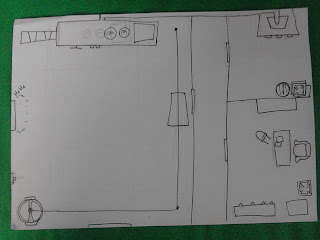To get a better idea about the mechanics and design of the level, I made a paper prototype vestion of the game. The main goal of each level is to find the ghost thats hiding somewhere, and the player would have to work out how to get to it. As a group we all descused the different macanics that could be featured in the game and when through different layouts. We then decided on a simplistic layout that better uses the limited space we have to make the level.

As the character is a spirit midiam, we wanted to give her some sort of powers the player to use. At first I thought of giving her some sort of amulet that she can use to track the ghost, which would play into the hide and seek element. But then realized that the whole purpose of the game is to get to the ghost, which you can't do unless you already know where it is. Instead, we made it so the player can easily tell where the ghost is as it redaiats a blue light, making the goal easier to visualize. I changed the amulet to a cristil ball that florts besides the player and acts as a light scourse.
The player will also have a small bag in wich she keeps all the items that can be collocated during each level. We then made desided to make this the gui for the inventory.
I definitely wanted there to be sepret rooms for the player to search through as it would keep the game interesting. So we went with a main room, which will have mostly iron smelting macheans, so the player can immediately see its a factory. Theres also a hallway that leads to a spare room with a generator, and an office.
The level will start in the main room. During the cut seacn you will be abale to see that the ghost has hidded behind a door. During the game, the is very obvise as she will eminat a light that will be easy to see. This is where the player wants to go, but the door is locked. In this room there is also a molding meachean, a cabinet blocking a door and a smelting pot.
The machean alrady has a key mold in it, but theres no power. If the player pulls the lever, it will move the smelting pot past the cabinet and too the machean. The pot is empty and brocken, but it still knocks down the cabinet, which allows the player to go into the hallway. A kay also falls out of the cabinet which they can pick up.
The first door leads to the spare room. I here they will be a genatater and a wench. The genatater can power the machean in the first room, but a seaquant much be imputed to tern it on. The wench can be used to fix the smelting pot.
In the office, there will be a locked bookcase. The player can use the small key to open it and find a peace of paper. This paper will have the answer to how to start the genatater. The player can also find some silver cutlaty hidden inside the draws in this room.
Once the genatater is on and the pot fixed, the player will need to put the silver into the pot so it can be melted and ternt into a big key. This key can then open the door where the ghost is and the first level will be complete.
After showing pears and letting them play though it, I realized they could melt the wrench it make the key instead of needing to find the silver. Because of this we desised to cut the cutlery out the game.


















































